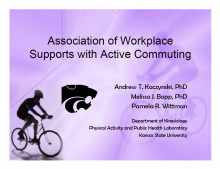We are pleased to announce an exciting new alliance between Active Living Research and GP RED to co-host and coordinate...
Association of Workplace Supports with Active Commuting

Presentation at the 2010 Active Living Research Annual Conference
Background:
Active commuting (AC) is the practice of walking or biking to work and offers a promising means to integrate recommended levels of physical activity into daily life routines (Dora, 1999; Tudor-Locke et al., 2001). Indeed, numerous health benefits from AC have been identified, including improvements in VO2max, HDL cholesterol, blood pressure, and insulin levels, and a reduced risk of obesity, cardiovascular disease, stroke, and all-cause mortality (Andersen, et al., 2000; Gordon-Larsen et al., 2009; Hamer & Chida, 2008; Lindstrom, 2008). Moreover, AC has the potential to facilitate positive social, environmental, and economic outcomes (Litman & Doherty, 2009).
Despite these benefits, rates of AC in the U.S. remain low. Data from the 2001 National Household Transportation Survey show that 91% of respondents reported an automobile as their usual mode to work, while only 5% took public transit and 3% walked (Hu & Reuscher, 2004). At the same time, surprisingly little research has examined influences on AC, especially among adults, with distance, motivations to avoid parking hassles, reduce expenses, increase one’s health, and reduce air pollution, and an overall 18-item environmental index identified as salient correlates of AC (Craig et al,. 2002; Merom et al., 2008; Ogilvie et al., 2008). However, although research has looked at personal and community-level environmental influences on AC, few, if any, studies have examined how workplace supports are related to the likelihood of walking and biking to work.
Objectives:
The purpose of this study was to examine the association of cultural and physical workplace supports for AC with employee AC behavior.
Methods:
An online survey was conducted from August to December 2008. Participants were recruited through listservs, links from local websites, and fliers provided to large area employers. Eligibility criteria included living and/or working full or part-time in Manhattan, KS and physically able to walk or bicycle. In total, 375 people completed the survey. The mean age was 39.4+12.9 years and participants were primarily White (90%), female (61%), and highly educated (95% high school diploma or greater), which is very representative of the city population. Respondents indicated their gender, age, race, education level, and estimated walking time to work (dichotomized as less or greater than 20 minutes). Cultural supports for AC were measured with two Likert-type questions about i) perceptions that their employer encourages AC (recoded as ‘none to a little’ vs. ‘some to a lot’) and ii) the perceived number of co-workers who actively commute to work (recoded as ‘none’ vs. ‘some’). A dichotomous variable was then created specifying participants with neither type of cultural support or those with at least one cultural support. Physical supports for AC were measured with three ‘yes/no’ questions about the presence of bike parking, bike storage policies, and showers/lockers at the workplace. These variables were summed to designate respondents with zero, one, or two or more of the three types of physical supports. Participants were also asked to indicate the number of times per week they walked and biked to or from work, and a dichotomous AC outcome variable was created indicating zero trips versus at least one trip by foot or bike. Binomial logistic regression was used to predict the likelihood of AC at least once per week according the presence of cultural and physical workplace supports, with the zero supports category as the reference group for each model.
Results:
About one-quarter (26%) of the sample reported actively commuting to or from work at least once per week. Three-quarters (76%) reported that their workplace possessed at least one (of two) cultural supports for AC. About one-third (30%) reported their workplace had zero (of three) physical supports for AC, while 35% and 36% reported one and two or more physical supports, respectively.
In multivariate models controlling for age, gender, race, education, and perceived walking time to work, persons who reported one or more cultural supports for AC were more likely to actively commute at least once per week (B=2.56, CI=1.19, 5.98). Likewise, persons who reported two or more physical supports for AC were significantly more likely to actively commute at least once per week than those who reported none (B=2.46, CI=1.10, 5.47), but participants reporting only one physical support were not (B=.73, CI=.31, 1.71).
Conclusions:
The present study found that individuals with a more supportive cultural and physical environment were more likely to walk or bike to work, and it thereby suggests possible strategies to increase AC behaviors. Most salient perhaps are some of the recent government policies offering tax breaks or other financial incentives for employers to encourage AC among employees (e.g., provisions in H.R. 1424). Other approaches could target social support and cultural norms around AC within a workplace (Wen et al., 2005). In summary, this study adds to the small body of existing literature concerning AC, and provides understanding about the social-ecological influences on this behavior beyond the individual.
STAY UP TO DATE
RECENTLY ADDED TOOLS & RESOURCES
MOVE! A BLOG ABOUT ACTIVE LIVING
The "Active Living Conference" aims to break down research and practice silos and...







